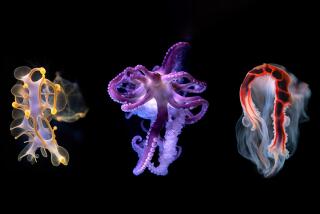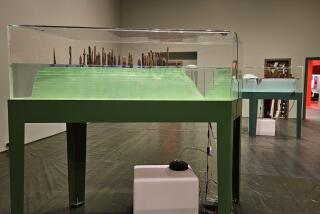Dave McKenzie at REDCAT
IF you were in Westwood at lunchtime Wednesday, you might have come across an unusual sight: about 50 people sitting on the sidewalk in office chairs. If you stopped to talk with one of them, you might also have learned that the motley lineup was a work of art.
Specifically, it was a happening, an event scripted by the late artist Allan Kaprow, who’s the subject of a retrospective exhibition on view across town at the Museum of Contemporary Art’s Geffen Contemporary.
In conjunction with the show, which will run through June 30, a host of local arts institutions, schools and community organizations are reinventing Kaprow’s quixotic, ephemeral works all over the city. (See www.moca.org/kaprow for a full list of events.)
The work that took place Wednesday was titled “Museum Portraits,” and it involved the entire staff of the Hammer Museum (except security guards) wheeling or carrying their office chairs onto the sidewalk behind the museum. They sat there for about an hour, handing out fliers, chatting with passersby and, as the time wore on, shivering in the building’s shadow.
“I wasn’t that excited about sitting in the street in the cold,” said Christine Lanoie, the museum’s manager of foundation and government relations, but she admitted that the happening had exceeded her expectations by giving her a chance to talk with people she wouldn’t normally interact with.
Several pedestrians did stop to talk: about the happening, Kaprow or the museum. Upon being told that she was now a part of modern art, one elderly woman exclaimed, “Oh, boy. Well, thank you. That’s good!”
That kind of direct, open-ended interaction is a hallmark of Kaprow’s work.
“It’s about human behavior,” said writer Judith Hoffberg, a friend of the artist’s who came to participate in the happening. “You have all these individuals, and everyone has a different reaction.”
Kaprow, who died in 2006 at age 79, conceived “Museum Portraits” in 1977 for the Hamburger Kunsthalle in Germany, but it was never enacted because the museum director thought it would be a “victimization” of his staff. By contrast, Hammer Director Ann Philbin said the museum chose the work precisely because it presented an opportunity to engage with the public.
“It’s very much in line with what we do,” Philbin said, “a celebration of artists and their vision.”
As one of the first artists to consistently make action and participation the center of his art, Kaprow was interested in “a kind of activity that maybe made you see something or think about something or experience something,” said artist Paul McCarthy, a longtime friend who helped organize the current retrospective. It was often, he said, “a type of absurd activity, but I think an activity to make you reflect on your life.”
“Right now, Kaprow is critical for a number of younger artists because they are thinking about work outside the commodity,” McCarthy said.
By coincidence, that description could apply to 31-year-old Dave McKenzie, whose first solo exhibition in Los Angeles will open at the Gallery at REDCAT on Wednesday .
McKenzie, based in Brooklyn, N.Y., is best known for performance-based works that transform everyday interactions into art. By asking viewers to look more closely at seemingly banal activities, his work, like Kaprow’s, raises basic questions about our place in the world and how we relate to one another.
For last fall’s Performa biennial in New York, McKenzie sat on a bench for three hours conversing with passersby, walked the streets of Harlem wearing a Bill Clinton mask and, in a piece titled “Private Dancer,” danced without music for six hours at the Studio Museum Harlem, beckoning visitors to join him.
Although there’s certainly a good measure of humor in his work, chance and the unexpected also play a huge role, says Romi Crawford, curator and director of education and public programs at the Studio Museum Harlem.
Crawford recalls the air of uncertainty created by his silent dance party: “Who’s going to walk in the room? Are they going to get it? Are they going to care to dance?”
For McKenzie, however, people who choose not to interact with him are as much a part of the work as those who do.
“Anyone can do anything: good, bad, in the middle,” he said by phone shortly before leaving for L.A. and the REDCAT opening. “So, the only question is, why choose one thing over another?”
Through his work, McKenzie hopes to make us (and himself) more aware of the countless minute decisions we make every day and perhaps to reevaluate things we take for granted.
“I’m here, you’re here -- this might be a reasonable way to proceed,” he said, “to move closer to one another . . . to be critical of the fact that for the most part, we’re totally oblivious to one another.”
McKenzie has not planned any performances for his REDCAT show, but his sculptures, videos and paintings convey a similar everyday quality.
One work features a screen door perforated with the words “Should I stay or should I go?” Another presents three cardboard boxes from General Electric refrigerators in different positions -- upright, horizontal and flattened -- suggesting the box’s evolution from commercial packaging to makeshift shelter to break-dance stage.
“I’m interested in re-purposing objects and situations,” McKenzie said, “how really the same thing can be used and reused.
“I decided that the works would address things that are the most important to me in terms of how I live, and that way they would be like other things, other decisions I make.”
In this sense, art making is no different from any other activity; in fact, McKenzie sees it as a way of compensating for missed opportunities.
“I’m never perfect, and I acknowledge that,” he said. “But making the work is sort of the best me that I am, the place where I’m always willing to go a little bit further.”
More to Read
The biggest entertainment stories
Get our big stories about Hollywood, film, television, music, arts, culture and more right in your inbox as soon as they publish.
You may occasionally receive promotional content from the Los Angeles Times.










